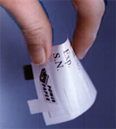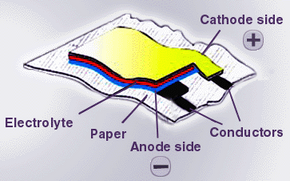It's amazing to watch as computers and other everyday electronic devices become thinner and thinner. Soon a laptop computer could be as thin as a sheet of paper. We'll just fold up our handheld computers and stick them in our back pocket. New innovations like electronic ink are making this vision of the future a possibility that soon could be realized.
Yet, as new technologies are slimming down the size of electronic devices, power supplies have not slimmed down at the same pace. Power Paper, an Israel-based company, has recognized the need for a thinner power source that will not only power electronic devices, but also fit into disposable devices like games, greeting cards, smart cards, luggage tags and some medical devices. And as Power Paper is looking for companies to license its paper-thin battery technology to, it is already developing disposable products using the technology that will debut in the second half of 2001.
Advertisement
With the development of computerized clothing, wearable computers and disposable cell phones, this ultra-thin battery technology is likely to have widespread applications. In this edition of How Stuff Will Work, you'll learn how these paper-thin batteries work and how they could soon be powering a variety of everyday products.

